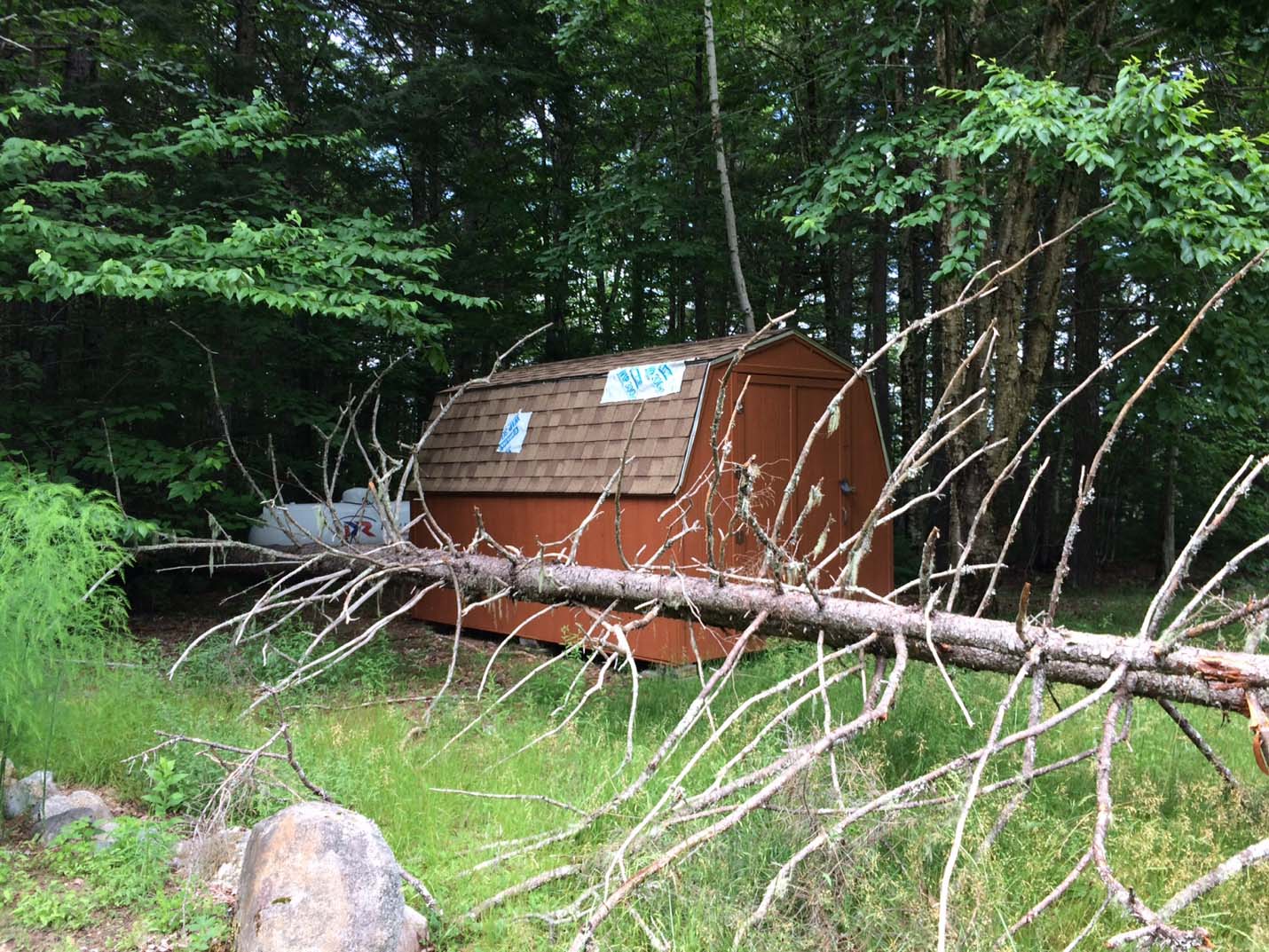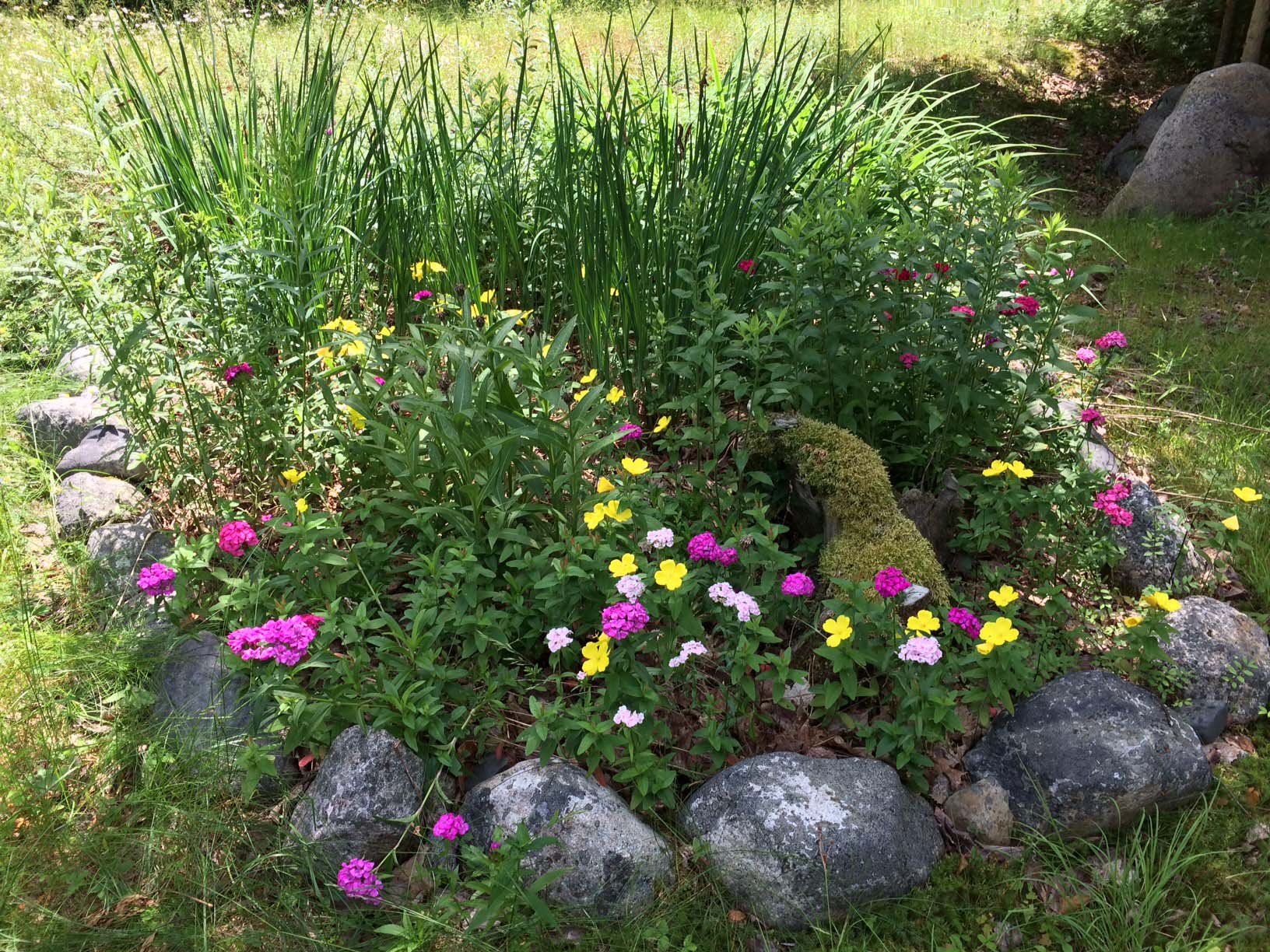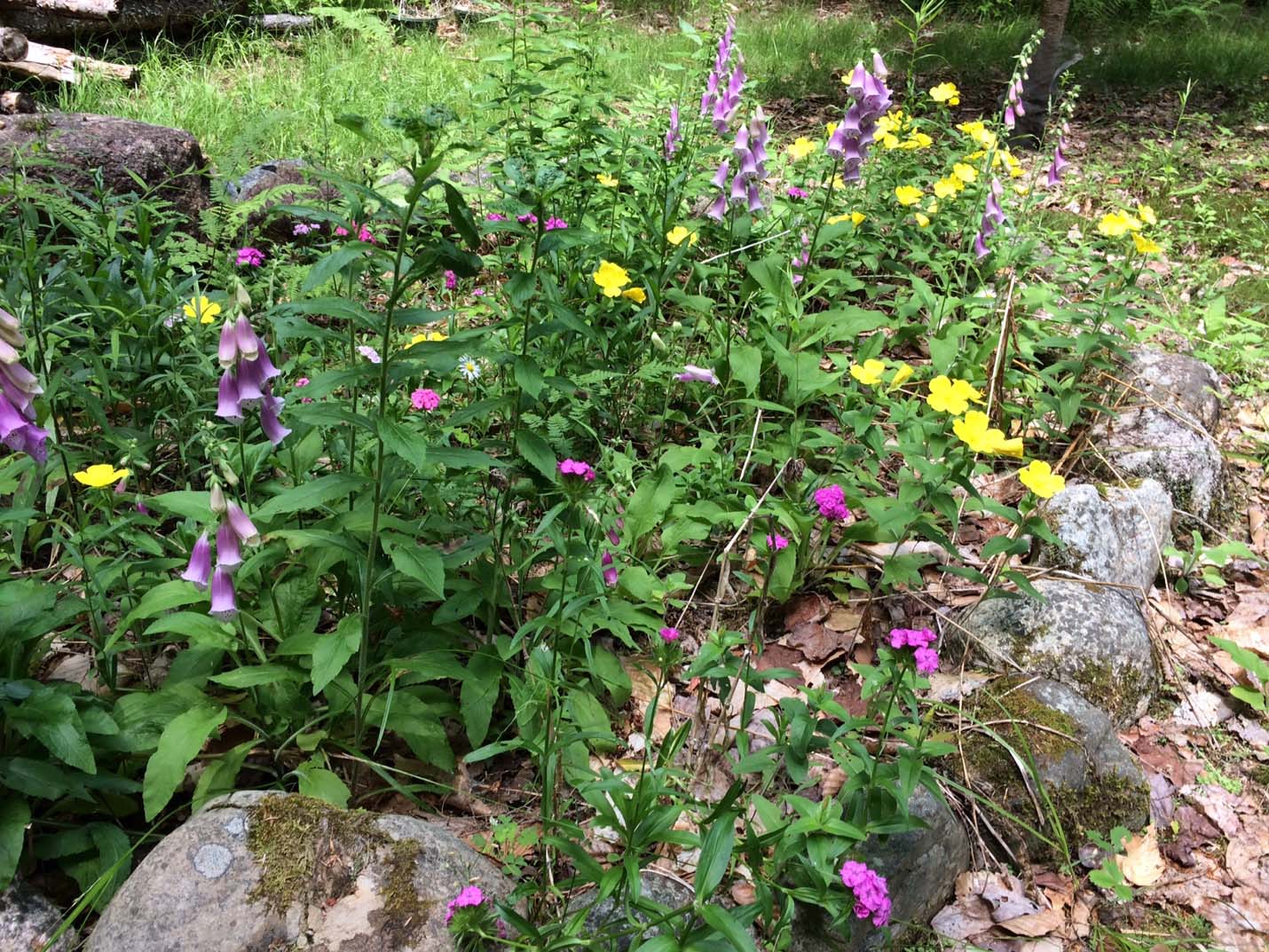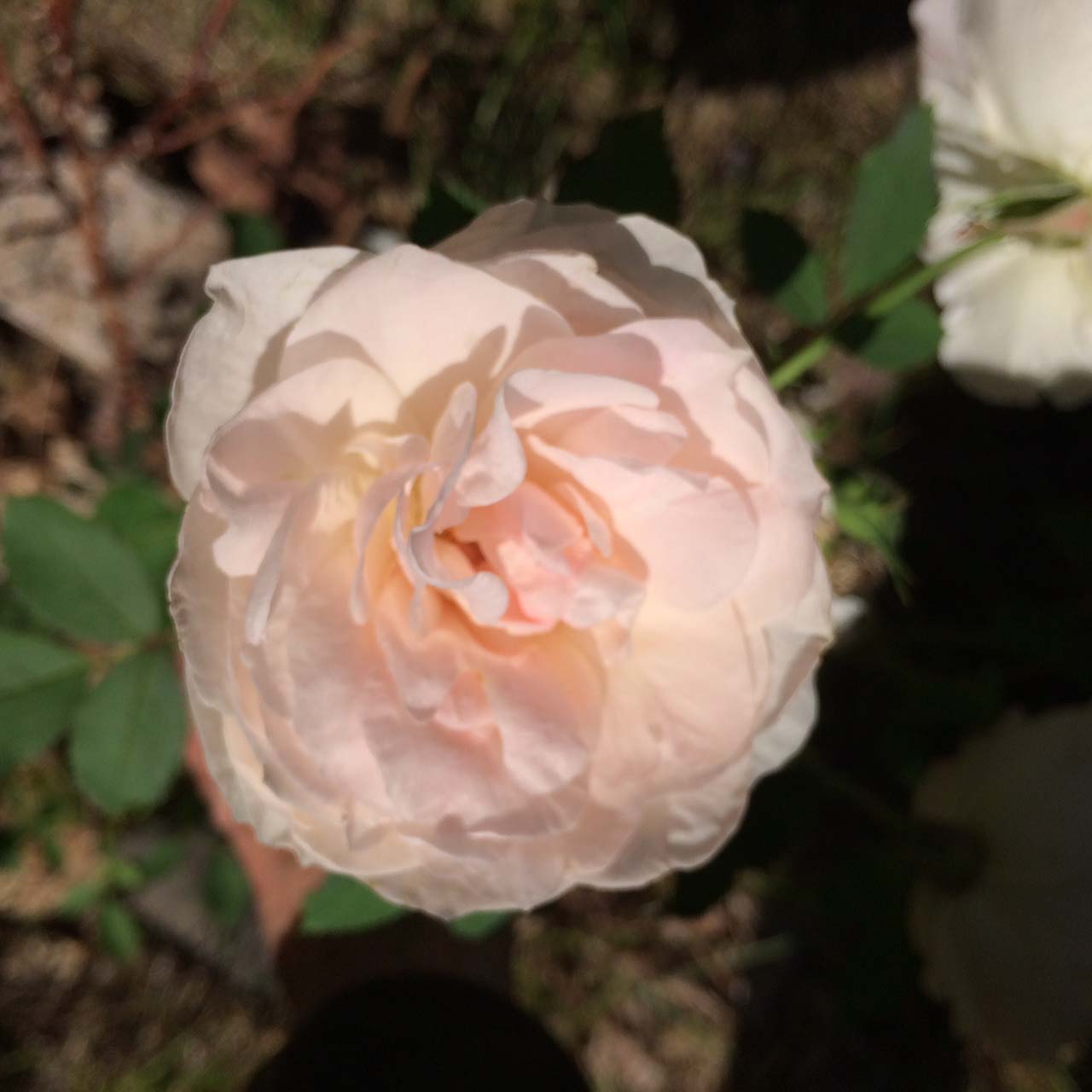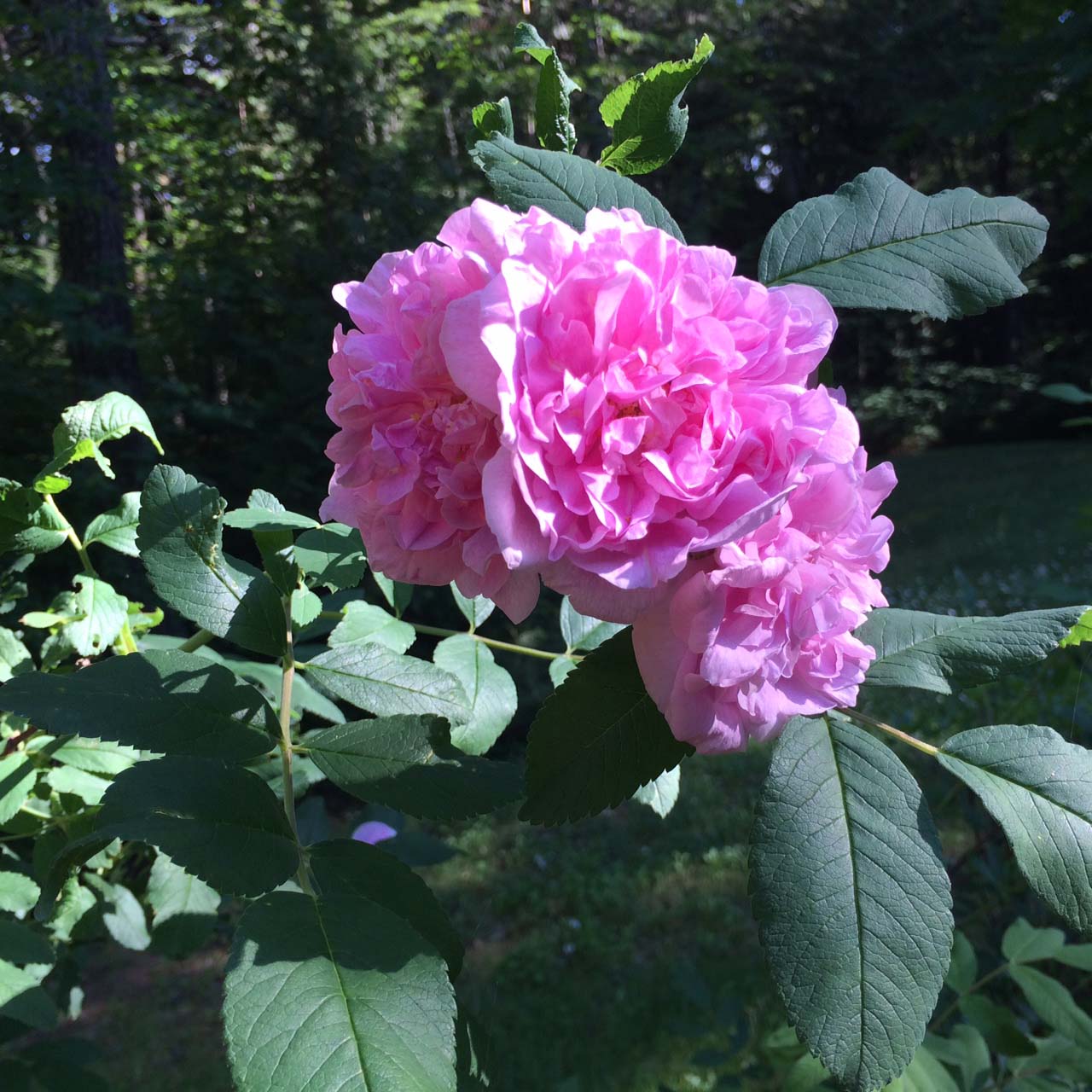|
Nature Abhors a Vacuum
Nature abhors a vacuum…and nature will fill a vacuum if no human is around to contain it. Such was the situation when arriving a month later than usual at our Maine camp.
I had estimated that the grass in the yard was calf-high, and all going to seed, but when I stood next to a stalk, it was above my knees! This posed a challenge for the lawnmower, which in most runs through, would mat it down rather than cutting it off low, necessitating dragging the mower back in the opposite direction. The daisies going out to the septic field were particularly difficult because the stalks are thicker than grass. Both Bill and I tackled the job, and in 3 stints over a few days (between rain), we had won the battle.
Seeds had already propagated from last year’s garden, despite the plants being pulled up and rototilled under last fall. One lettuce had come up and several cilantro, and when I cleaned the fallen leaves and old annuals out of the flower planters (which are half barrels from whisky – yes, Home Depot sells them up here), there was cilantro growing in those, and they are located way on the other side of the house from the garden! I also uncovered a fat toad in one barrel; it hopped out to the ground and was probably not happy losing its vegetative shield from potential foes, but the next day it was right back in that barrel despite nothing to cover it. So, wind moves seeds nicely, and they also get the refrigeration treatment over winter, but are still viable. Then there’s the purslane that grows rampant in both the small and big vegetable gardens; this is a succulent that is a superfood, full of antioxidants, omega 3 and all kinds of vitamins, which I don’t want to eliminate, although it is a nuisance amongst the other perennial foods and herbs such as asparagus, chives, thyme and rhubarb. It’s a matter of hand-weeding around these crops, which is painstakingly time-consuming. The purslane goes in my luncheon salad almost every day, adding a nice crunch and mild flavor, as well as all those healthy attributes. In addition to these happy and useful elements in the garden, there was grass and weeds of every description, and nearby trees send their roots through the garden soil as well. The big garden got rototilled a couple of days ago, and there were tree roots 3/8” in diameter; I have called for Woodsman Bill to use his chain saw on some trees, but unfortunately, he loves living trees, so this task is way down on his priority list.
Back in May, we had been warned about, and helped by our wonderful neighbor to remove, a large, 60+ foot spruce tree that had fallen on our little shed, causing a bit of damage to the roof. With his tractor, Jeff was able to pick up the tree and lay it beside the shed perfectly, and he temporarily closed up the roof damage with ice and water shield. It looked like the tree had been hit by lightning because the trunk was splintered up about 5 feet from the bottom. The real roof repair is scheduled for early August by Todd who is coming to stain our garage; he also does a lot of carpentry.
Nature is represented not only by vegetation, but also by animals. Under some of the limbs of this fallen spruce, in the tall grass, a robin had made its nest and laid 2 blue eggs. By the time Bill got this tree all cut up and we needed to mow, the mother robin had abandoned the nest, so that was the end of those eggs.
Mice! Bill hooked up the battery to the car that we leave here in the garage, got into the driver’s seat to drive it out into the yard, and encountered a pile of car insulation at his feet, a wonderful mouse nest. We’ve had lots of mice in the car over the years when it sits in the yard all summer long, but never while it’s been overwintering in the garage. In the past, they’ve made homes in the glove box, air filter, and ventilation system. One year, we turned the AC on quite high and sliced and diced a couple of mice, spraying their body parts and contents all over. Needless to say, our car, despite cleaning it out as best we can, spraying and doing all else possible, has never lost the mouse smell, which if you’ve never experienced it, is indeed foul, and we hear the complaint not only from ourselves, but from our Vermont son when we visit him and we use our car to go anyplace together. Now I’ve put mouse traps outside the car and a new poison that comes in a plastic casing so other animals, including domestic pets from our neighbors, can’t get into it.
Mouse traps are deadly – I have caught two mice in them so far this year – but also an occupational hazard. There is one trap that has a very potent and easily triggered hitch. I have snapped fingers on my left hand in that one twice, first between the middle joint and knuckle of the index finger leaving a big bruise and hard bump, then the thumb on its knuckle joint, leaving a bruise, hard bump and blood blister. OUCH! I bought the poison as an alternative when we went to town last week.
Mice will nest wherever they find it comfortable. I opened up the cover to our 500-gallon propane tank to turn it on, and in a bunch of deciduous leaves under there were 5 little furry mice. They weren’t very quick about moving, but, as I was surprised to see them there (this was a first), I had nothing with which to do them in, so they eventually skedaddled. I caught one later in a trap.
Then there’s the mailbox. For the first time, we took our mailbox down, post and all, because it regularly got hit by the snowplow when the snow was higher than the mailbox and the operator couldn’t see it. We stored it in the garage last winter. Bill put the mailbox back up at the road so we could get our mail delivered and then reported that he sensed there was something in the far back part of it; the box is maybe 18” deep, and hard to see that far back without a light. So, I went down a few days later to deposit outgoing mail, looked in, and got the same sense – MICE! But these were all dead, dried carcasses, totally fused to the back wall of the box; I took a stick to scrape 9 bodies off the back wall and out of the box, and realized at some point, when other things settle down around here, that I must go back with some steel wool, rasp the heck out of that back wall, introduce some Lysol and then spray paint the thing as it has begun to rust from the mouse fluids.
I have seen where the mice got into…and/or out of…the garage; they ate away a small corner of the bottom weather stripping. I have repaired that, but I’m beginning to conclude that they may have been in the car when we put it away last fall, made lots of babies in the car and mailbox, and then the adults needed to get out, and found a way to do that, abandoning the babies to die; the babies had fur, so were not still little “pink erasers.” As I said, in 27 years, this is the first time we’ve had them in the garage, and hopefully the last! BTW, we’ve never had them in the house, but other owners have found multiple mice drowned in their toilets.
There is some creature that likes the vegetable peels that I’ve been throwing in one of my 3 compost bins; it knocks down the top crib log every time, so it has to be something fairly large. We do have racoons and porcupines around here, so they are possibilities. I have found, as usual, shed snake skins near the gardens; there are no poisonous snakes here (yet), but garter and pencil-thin ring-necked snakes, which are no bother, but I do like to know where they are, not to be surprised. Checking my mouse traps one day, I found slugs on the sides of two of them, and readily took care of them. They chew into asparagus spears just when they come up, strawberries when just about ripe, and other things they find delectable, so when I find them, they are goners.
While nature can be challenging in these situations, it can be really beautiful and enchanting. The rhododendrons had already gone by when we arrived, but the roses of three varieties, sweet Williams, foxglove (digitalis), evening primrose, astilbe, cranesbill, and spiderwort (Job’s tears) were all in bloom. Since then, the day lilies have opened, the hostas and Anthony Waterer spirea are about to, and the hydrangeas and phlox are not too far behind. The blueberries are mostly white and some with pink, but I picked and ate 3 blue ones yesterday – they are coming! Bill said the raspberries are out, but I haven’t been up the road to pick them. There are a few chanterelles, but although it seems like we’ve had a lot of rain days, it has actually been dry since not much rain came down. In fact the lake is extremely low, but I understand that’s because there is a broken board in the dam which the owner, a wood processing mill, is supposed to repair sometime this summer; they usually wait until the end of the season when the water level is normally low, but we and many others are going to have to put an extension onto our walkways or docks to ensure that we can get in and out by boat.
This garden, one of my favorites, has sweet Williams and evening primrose in bloom, with day lilies, potentillas, and two kinds of goldenrod coming along. It also has a really neat dri-ki covered with moss and tiny red flowers; dri-ki is an Indian word for lake driftwood.
This garden has foxglove (digitalis), along with sweet Williams (can never have enough of those!) and evening primrose; it also has two varieties of local ferns (Cinnamon and Sensitive).
And here are two varieties of roses, Morden’s Blush and Theresa Bugnet (3 flowers on one stem):
The edge of the woods is filled with bunchberries, so showy with their red berries. Heal-all (self-heal) has been out for a while, along with so many other forest and lake-side treasures.
When I’m working out in the yard, I draw pleasure from listening to the birds, such as phoebe’s, mourning doves, and hummingbirds; one of those zipped by my ear the other day as I was weeding, what a surprise! That same day, 2 playful red squirrels started through the garden; one went whizzing through, but the other stopped on seeing me and ran back to a nearby tree, ready to climb it quickly if I moved towards it. I’m not terribly fond of the squirrels as they can be destructive, but I’m less fond of the raucous ravens who come by from time to time; their voices are truly loud and grating. Bill and I sometimes go out in the boat to the big part of the lake, turn off the motor and just float, chatting and watching nature go by: bald eagles soaring overhead so effortlessly, sometimes swooping down to catch a fish or perching in a tree to wait for another opportunity; and loons that might pop up no more than 30 feet away. If close to shore, we may see painted turtles sunning themselves on rocks, or in the evening, hear the bullfrogs croaking.
It is truly a magical place up here, and I’m happy to report that for more than a year now, I have been part of a small committee working to conserve over 2,000 acres of forest touching both our Sysladobsis Lake as well as Horseshoe Lake nearby. The committee enlisted the help of The Trust for Public Land, and out of 22 applications from across the country to the Community Forest and Open Space Program of the U.S. Forest Service, our project was ranked FIRST; a sizeable grant has come along with that towards the purchase of this tract, which we hope to complete by mid-2021. The Downeast Lakes Land Trust (DLLT) will take ownership of it, manage it along with the 55,000+ acres of working forest and 89 miles of undeveloped shoreline they already have conserved in our area, and all will be open for recreation, education, and forest management for wildlife habits and wood production. All exciting!
|
